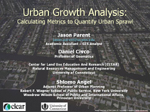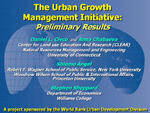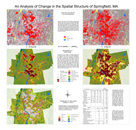| Papers |
| Angel, S., J. Parent, and D.L. Civco. 2007. Urban Sprawl Metrics: an Analysis of Global Urban Expansion Using GIS.Proc. 2007 ASPRS Annual Convention, Tampa, FL 12 p. |
| Angel, S., S. Sheppard, D. Civco, R. Buckley, A. Chabaeva, L. Gitlin, A. Kraley, J. Parent, and M. Perlin. 2005. The Dynamics of Global Urban Expansion. Transport and Urban Development Department. The World Bank. Washington D.C. |
| Civco, D.L., A.A. Chabaeva, S. Angel and S. Sheppard. 2005. The Urban Growth Management Initiative: Confronting the Expected Doubling of the Size of Cities in the Developing Countries in the Next Thirty Years - Methods and Preliminary Results.Proc. 2005 ASPRS Annual Convention, Baltimore, MD 14 p. |
| Presentations | |
 |
Urban Growth Analysis: Calculating Metrics to Quantify Urban Sprawl- The presentation describes a study that measured changes in urban sprawl for a global sample of 120 major cities over a 10 year period. Numerous metrics are proposed that enable rigorous measurements of the spatial structure in the study cities. ASPRS 2007. 1.0 Mb |
 |
The Urban Growth Management Initiative: Preliminary Results- Conducted as part of a team that included Columbia University and Williams College, CLEAR researchers looked at urban extent and expansion over a ten-year period for 120 cities with a population over 100,000, worldwide. This study, funded by The World Bank and the National Science Foundation, is providing insight into the relationships of population growth and urban expansion in developing countries. ASPRS 2005. 4.4 Mb |
| Posters | |
 |
An Analysis of Change in the Spatial Structure of Springfield, MA - this color poster measures 42" by 40" and illustrates the change in the urban spatial structure of Springfield over a roughly 10 year time period. The first set of maps show land cover data that was derived from satellite imagery. The remaining maps depict the manifestations of urban sprawl such as the urbanized open space and the urban footprint. The tables quantify these sprawl manifestations and characterize the compactness of the city.This poster was created as the part of the research conducted under the "Urban Growth Initiative" project funded by The World Bank and the National Science Foundation. |